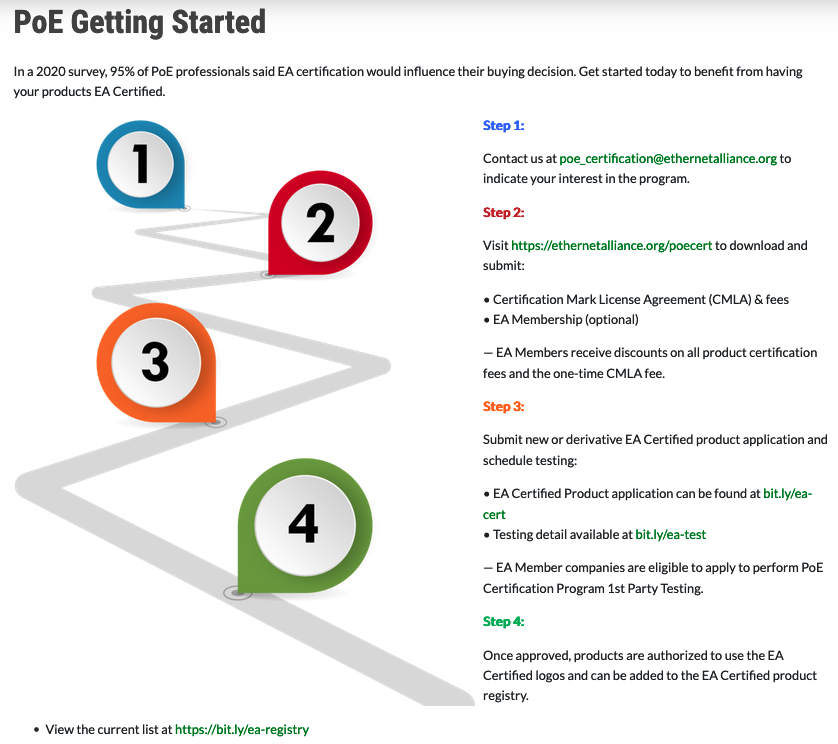Cabling-System Design and Installation for Delivering Power via PoE
Power over Ethernet (PoE) bundling was added to the National Electrical Code (NEC) in the 2017 edition due to fears of large bundle heating. It was heavily revised for the 2020 edition and included input from a broad consensus of PoE experts.
Category cable bundling is addressed in Article 725.144 in the NEC. Table 725.144 lists the permitted per conductor ampacities for bundle sizes at the ‘1 around N’ steps (7, 19, 37, etc.) for conductor gauges of 26, 24, 23, 22 and cable temperature ratings of 60, 75, and 90C. It is important to realize Table 725.144 is specified at 30C ambient while the IEEE and cabling specs expect a max 45C ambient with a 15C rise (keeping the cable under 60C as that is the max temperature that the channel is specified for data transmission).
Therefore, analysis of the table has to happen after adjusted to 45C using Equation 310.15(B). Once adjusted for temperature, one finds that the 92-192, 23AWG, 75C entry is 450mA and the 62-91, 24AWG, 75C entry is 460mA. The maximum per conductor current for an IEEE 802.3™ compliant Class 8 device is 433mA, so both of these operating points can support IEEE Class 8 (90W from the PSE, 71.3W at the PD). Since Cat6A is typically 23AWG and Cat5e is typically 24AWG, this means a Cat6A, 75C cable can be used in bundles of 192 and Cat5e, 75C cable can be used in bundles of 91 (it is important to confirm the wire gauge and not simply assume).
I will take a pause here to point out the tremendous amount of power going into these bundles. If these bundles all carried 433mA per conductor from a 52V source (the IEEE 802.3bt minimum voltage for a Type 4 PSE), you are delivering 17.3kW into the 192 cable bundle and 8.2kW into the 91 cable bundle. This is an immense amount of power to deliver to PoE devices and quite unlikely to be found in the typical installation. Additionally, the entire large cable bundle wouldn’t all run from point A to point B. It would get broken down into smaller bundles along the way, further reducing the chance for bundle heating.
Before continuing, let’s take another pause to talk about the bundle heating. There is no fear of a bundle causing a fire. If a bundle was oversized and/or improperly installed, the cables in the center of the bundle would bear the brunt of the heating. This would degrade the insulation and would negatively affect data transmission or even cause a short between power pairs. The IEEE 802.3™ compliant PSE would quickly sense this short and shut off power (50ms or less). No fire, no loss of life or property – except for possibly damaged center cables. What you will have though is an angry customer that will demand you replace their now worthless cable in the middle of a large bundle.
For the installer that doesn’t want to think about conductor current and bundle size, and make it easier on the inspector, they will go with smaller bundles. If the bundle size is 37 or less, there is nothing to think about with respect to the cable specification for PoE. Any gauge of horizontal cable (24, 23, 22AWG) at any temperature rating (60, 75, 90C) will be compliant for IEEE 802.3bt™ PoE and compliant to 725.144. If you want to make it even easier, the equipment offers a convenient method. These large systems are always arranged in groups of 24 due to the way the RJ45 jacks are manufactured. Keep these bundles of 24 as the maximum size. It will make it easy for an inspector to count the cables by eye. You can loosely group these bundles while still in the air-conditioned data closet, telecom room, etc. and as they exit the room. Immediately separate the bundles by 1.5 inches once in the plenum. This will provide a path to an easy inspection while also future proofing in the case of a new install that isn’t using Type 4 PSEs by having the cable plant ready for equipment upgrades.
One last word of caution, this preceding discussion revolves around IEEE 802.3™ compliant PoE. If you are using some pseudo-PoE system that is not IEEE 802.3™ compliant, the installer will have to determine the conductor current, consult Table 725.144, temperature adjust using EQ 310.25(B) and then likely walk the inspector through the design details. In this case, I would recommend using Limited Power (LP) rated cable as it will be designed to a specific current level for bundles up to 192. This will make the inspection easier as the inspector can look at the required marking on the PSE and the current capacity of the cable to ensure they match properly.





